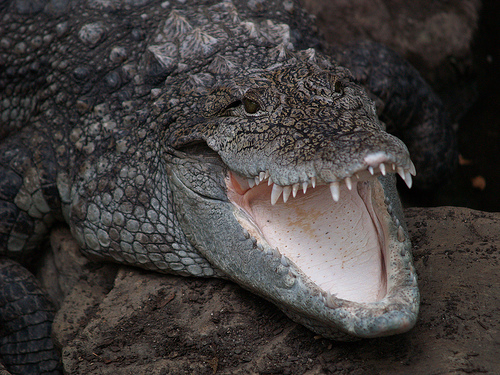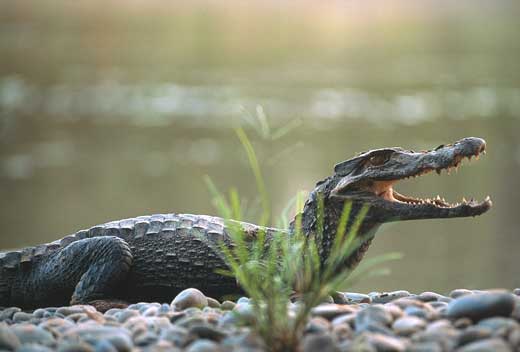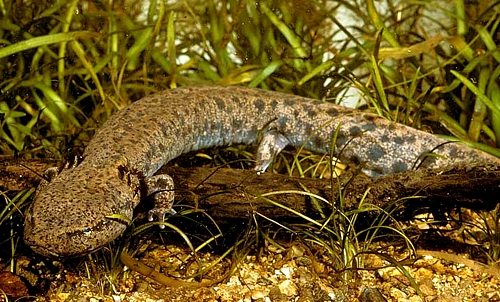Komodo Dragon
In the wild, large adults tend to weigh around 70 kg (154 lbs). Captive specimens often weigh more. The largest verified wild specimen was 3.13 metres (10 feet 3 inches) long and weighed 166 kg (365 lbs), including undigested food. Komodo dragons have a tail that is as long as the body, as well as 52 serrated teeth that may be 2.5 centimetres (1 inch) in length.
They have red, blood-like saliva, as they bite their own gums when they eat, thus creating an ideal culture for the virulent bacteria that live in their mouths. It also has a long, yellow, snake-like tongue. Males are larger than females, with skin color from dark gray to brick red. Females are more olive green, and have patches of yellow at the throat. The young are much more colorful by comparison, with yellow, green and white banding on a dark background.
Komodo dragons are found exclusively in Indonesia, on the island of Rinca and on several islands of the Lesser Sunda archipelago.They prefer hot and dry places, and typically live in dry open grassland, savanna and tropical forest at low elevation. As poikilotherms, they are most active in the day, although they do exhibit some nocturnal activity. Komodo dragons are largely solitary, coming together only to breed and eat.
They are capable of running rapidly in brief sprints, are excellent swimmers, and when young they climb trees proficiently through use of their strong claws. As they grow older, their claws are used primarily as weapons, as their great mass makes climbing impractical for adults.
For shelter, dragons dig holes that can measure from 3-6 feet wide (0.9-1.8 metres wide). Their sense of hearing is not particularly acute, and their visual discrimination (most especially of stationary objects) is poor. They use their tongue to detect taste and smell stimuli (as with many reptiles), which aids navigation in the dark. These lizards are apex predators, dominating the ecosystems in which they live. More..
Komodo dragons are the world’s heaviest living lizards. They can grow to a length of 10 feet (over 3 meters), with an average length of 8 feet (2.5 meters) and weight of 200 lbs (91 kg.). Females are usually under 8 feet and weigh about 150 lbs. (68 kg.).
The Komodo dragon’s keen sense of smell, if aided by favorable wind, enables it to seek out carrion up to 5 miles (8.5 kilometers) away. Despite its size, the Komodo is fast moving and agile. They can climb trees and like all monitor lizards they are good swimmers.
Their teeth are laterally compressed with serrated edges, resembling those of flesh-eating sharks. They have about 60 teeth that they replace frequently and are positioned to cut out chunks of its prey. The highly flexible skull allows it to swallow large pieces of its food. The Komodos mouth is full of virulent bacteria and even if its prey survives the original attack, it will die of infection later.
Young dragons up to 29 inches (.75 meters) live in trees and eat insects, birds, eggs, small mammals and other reptiles. They will descend from the tree for carrion.
DISTRIBUTION and HABITAT:
The distribution of Komodo dragons is restricted to the Lesser Sunda Islands of Rinca, Komodo, Flores and the smaller islands of Gili, Montang and Padar. Padar does not have a permanent population. The total range is less than 1,000 sq. km. Komodo National Park makes up all islands except Flores.
The natural habitat of Komodo dragons is extremely harsh by human standards. These arid volcanic islands have steep slopes and little available water most of the year. A short monsoon season often produces local flooding. The average annual temperature at sea level on Komodo island is 80F. degrees. Dragons are most abundant in the lower arid forest and savanna.
Outsiders found out about the Komodo dragons after WW1 when a report came from a downed aircraft and the surviving pilot swam to Komodo Island. More..


